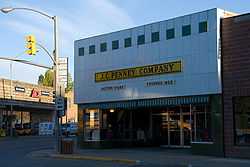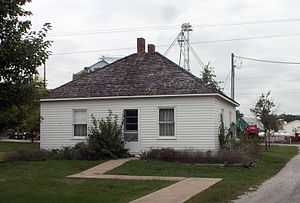James Cash Penney
| James Cash Penney | |
|---|---|
.jpg) Penney circa 1902 | |
| Born |
September 16, 1875 Hamilton, Missouri, U.S. |
| Died |
February 12, 1971 (aged 95) New York City, New York, U.S. |
| Occupation |
Businessman Entrepreneur |
| Years active | 1898–1971 |
| Known for | Establishing J. C. Penney department stores in 1902 |
James Cash Penney, Jr. (September 16, 1875 – February 12, 1971) was an American businessman and entrepreneur who, in 1902, founded the J. C. Penney stores.
J.C. Penney Stores

In 1898, Penney began working for a small chain of stores in the western United States called the Golden Rule stores. In 1902, owners Guy Johnson and Thomas Callahan, impressed by his work ethic and salesmanship, offered him one-third partnership in a new store he would open. Penney invested $2,000 and moved to Kemmerer, Wyoming, to open a store there. He participated in opening two more stores, and when Callahan and Johnson dissolved their partnership in 1907 he purchased full interest in all three stores.
By 1912, there were 34 stores in the Rocky Mountain States. In 1913 he moved the company to the Kearns Building in downtown Salt Lake City, Utah. The company was incorporated under the new name, J. C. Penney Company. In 1916, he began to expand the chain east of the Mississippi and during the 1920s, the Penney stores expanded nationwide, with 120 stores in 1920 (mostly still in the west) By 1924, Penneys' reported income of more than $1 million annually.[1] The number of stores reached 1,400 by 1929. The large income allowed Penney to be heavily involved in many philanthropic causes during the 1920s. By 1921 Penney had a home (Belle Isle) on Biscayne Bay in Miami. Penney and partner Ralph W. Gwinn had invested heavily in Florida real estate including 120,000 acres (490 km2) in Clay County. Some of this land became Penney Farms. This was also the start of Foremost Dairy Products Inc. Penney later recruited Paul E. Reinhold to run the dairy. Most of this work was halted when the stock market crash of 1929 and the Great Depression left Penney in financial ruin.
After the 1929 stock crash, Penney lost virtually all his personal wealth, and borrowed against his life insurance policies to help the company meet its payroll. The financial setbacks took a toll on his health. Penney checked himself into the Battle Creek Sanitarium, where he was treated. After hearing the hymn "God Will Take Care of You" (written by Civilla Durfee Martin) being sung at a service in the hospital’s chapel, Penney became a born-again Christian.[2] Even after relinquishing daily operating management of the company, Penney continued his active involvement in managing the company and its stores. In 1940, during a visit to a store in Des Moines, Iowa, he trained a young Sam Walton on how to wrap packages with a minimal amount of ribbon.[3] He remained as chairman of the board until 1946, and after that as honorary chairman until his death in 1971. Until the end of his life he continued to go his office.
Personal life

J.C. Penney was born on a farm outside of Hamilton, Caldwell County, Missouri to James Cash Penney, Sr. and Mary Frances (née Paxton) Penney. He was the seventh of twelve children, only six of whom lived to adulthood. Penney's father was a Baptist preacher and farmer whose strict discipline included making his son pay for his own clothing once he reached his late pre-teens. His intentions after graduation from Hamilton High School were to attend college with the hopes of becoming a lawyer. However, his father's untimely death forced a change in plans, with Penney taking a job as a store clerk to help support the family. Penney's health problems caused him to venture west to Longmont, Colorado, in his early twenties, where he found employment with the previously mentioned Golden Rule stores.[4]
James Cash Penney married three times in his life. His first wife Bertha Alva Hess died of pneumonia, and the second wife Mary Hortense Kimball also died of unspecified medical issues in 1924. Finally Penney found lasting love with third wife Caroline Marie Autenrieth, to whom he was married forty-five years until his death.[5] By his first wife he had two sons, Roswell Penney and James C. Penney III. By his second wife he had another son, Kimball Penney. And by his third wife, he had two daughters, Mary Frances Penney and Carol Penney.
Penney lived in New York City at 888 Park Avenue, though he spent the winters in Palm Springs, California. On December 26, 1970, Penney fell and fractured his hip. Just a few weeks later, he suffered a heart attack and never fully recovered. He died February 12, 1971. The Reverend Dr. Norman Vincent Peale delivered the eulogy at Penneys' funeral. Penney was buried in the Bronx section of New York City. His grave, at the Woodlawn Cemetery, is not far from that of fellow retail entrepreneur, F. W. Woolworth.
Affiliations
Penney was a Freemason most of his adult life, being Initiated into Wasatch Lodge No. 1 Free and Accepted Masons of Utah, on April 18, 1911.[6][7] A member of both the Scottish and York Rites, Penney was coroneted a 33rd Degree on October 16, 1945, and received the Gold Distinguished Service Award by the General Grand Chapter, Royal Arch Masons, in Kansas City, Missouri in 1958. He typically wore a large ring showing his Masonic degree.
Penney was involved with the founding of the University of Miami and served on its Board of Trustees from 1926 to 1930.[8]
During the Great Depression, Penney teamed with Thomas J. Watson, President and Founder of IBM, Arthur Godfrey, the radio and TV personality; and Norman Vincent Peale, a minister, inspirational speaker, and author of The Power of Positive Thinking, to form the first board of 40Plus, an organization that helps unemployed managers and executives.[9] Penney was also member of two professional fraternities: Alpha Gamma Rho and Alpha Kappa Psi.
Penney founded the James C. Penney Foundation in 1954. The foundation was restructured in 1999 as the Penney Family Fund, and is no longer affiliated with J.C. Penney Co., Inc. or its corporate giving program. Today, the fund is part of the Common Counsel Foundation, an Oakland, California based consortium of family philanthropic foundations and individual donors. The Penney Family Fund endows organizations in Oregon, California, and Washington state that work to advance human rights, community social, political, and economic empowerment, government accountability, and environmental sustainability.[10]
Commemoration
- The J.C. Penney Conference Center at the University of Missouri-St. Louis was dedicated in his honor on January 23, 1972. The building was made possible through financial donations by Mr. Penney and his company.
- Mr. Penney was inducted into the Junior Achievement U.S. Business Hall of Fame in 1976.
- The J. C. Penney Historic District in Kemmerer, Wyoming was declared a National Historic Landmark in 1978.
- In 1994, Penney was inducted into the Hall of Famous Missourians, and a bronze bust depicting him is on permanent display in the rotunda of the Missouri State Capitol in Jefferson City.
- Hamilton High School in Hamilton, Missouri was renamed Penney High School.[11]
References
- ↑ "J.C. Penney - Family and Philanthropies". Retrieved 2007-04-13.
- ↑ "The Hymn That Saved J.C. Penney". Retrieved 2007-04-13.
- ↑ http://wiki.answers.com/Q/When_did_Sam_Walton_open_the_first_Wal-Mart
- ↑ Missouri Legends: Famous People From The Show-Me State by John W. Brown. Published by Reedy Press, St. Louis, 2008.
- ↑ Missouri Legends: Famous People From The Show-Me State by John W. Brown. Published by Reedy Press, St. Louis, 2008.
- ↑ Wasatch Lodge No. 1 F&AM of Utah
- ↑ Grand Lodge of British Columbia and Yukon
- ↑ Tebeau, Charlton W. The University of Miami. Coral Gables: University of Miami Press, 1976. p. 393.
- ↑ "About Us", Forty Plus of New York City
- ↑ Penney Family Fund profile at Common Counsel Foundation website
- ↑ http://www.hamilton.k12.mo.us/High%20School/phs%20homepage/phs%20homepage.htm
Further reading
- Kruger, David Delbert (2008). "J.C. Penney: Missouri Man, Wyoming Institution". Annals of Wyoming: the Wyoming History Journal 80 (2) (Wyoming State Historical Society). pp. 20–36.
- Kruger, David D., “James Cash Penney: The Impact of a Main Street Merchant on Oklahoma,” Chronicles of Oklahoma, 89 (Fall 2011), 260–87.
External links
- “Two American Entrepreneurs: Madam C. J. Walker and J.C. Penney”, a National Park Service Teaching with Historic Places (TwHP) lesson plan
- James Cash Penney at Find a Grave
| ||||||||
|